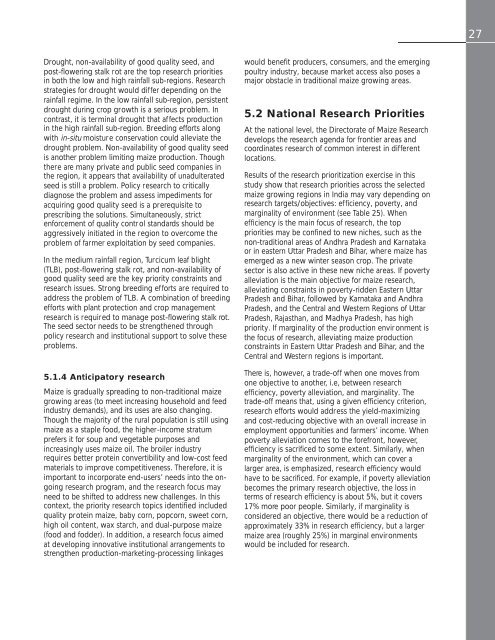Maize in India: Production Systems, Constraints - AgEcon Search
Maize in India: Production Systems, Constraints - AgEcon Search
Maize in India: Production Systems, Constraints - AgEcon Search
You also want an ePaper? Increase the reach of your titles
YUMPU automatically turns print PDFs into web optimized ePapers that Google loves.
27<br />
Drought, non-availability of good quality seed, and<br />
post-flower<strong>in</strong>g stalk rot are the top research priorities<br />
<strong>in</strong> both the low and high ra<strong>in</strong>fall sub-regions. Research<br />
strategies for drought would differ depend<strong>in</strong>g on the<br />
ra<strong>in</strong>fall regime. In the low ra<strong>in</strong>fall sub-region, persistent<br />
drought dur<strong>in</strong>g crop growth is a serious problem. In<br />
contrast, it is term<strong>in</strong>al drought that af fects production<br />
<strong>in</strong> the high ra<strong>in</strong>fall sub-region. Breed<strong>in</strong>g efforts along<br />
with <strong>in</strong>-situ moisture conservation could alleviate the<br />
drought problem. Non-availability of good quality seed<br />
is another problem limit<strong>in</strong>g maize production. Though<br />
there are many private and public seed companies <strong>in</strong><br />
the region, it appears that availability of unadulterated<br />
seed is still a problem. Policy research to critically<br />
diagnose the problem and assess impediments for<br />
acquir<strong>in</strong>g good quality seed is a prerequisite to<br />
prescrib<strong>in</strong>g the solutions. Simultaneously, strict<br />
enforcement of quality contr ol standards should be<br />
aggressively <strong>in</strong>itiated <strong>in</strong> the region to overcome the<br />
problem of farmer exploitation by seed companies.<br />
In the medium ra<strong>in</strong>fall region, Turcicum leaf blight<br />
(TLB), post-flower<strong>in</strong>g stalk rot, and non-availability of<br />
good quality seed are the key priority constra<strong>in</strong>ts and<br />
research issues. Strong breed<strong>in</strong>g ef forts are required to<br />
address the problem of TLB. A comb<strong>in</strong>ation of breed<strong>in</strong>g<br />
efforts with plant protection and crop management<br />
research is required to manage post-flower<strong>in</strong>g stalk rot.<br />
The seed sector needs to be strengthened through<br />
policy research and <strong>in</strong>stitutional support to solve these<br />
problems.<br />
5.1.4 Anticipatory research<br />
<strong>Maize</strong> is gradually spread<strong>in</strong>g to non-traditional maize<br />
grow<strong>in</strong>g areas (to meet <strong>in</strong>creas<strong>in</strong>g household and feed<br />
<strong>in</strong>dustry demands), and its uses are also chang<strong>in</strong>g.<br />
Though the majority of the rural population is still us<strong>in</strong>g<br />
maize as a staple food, the higher-<strong>in</strong>come stratum<br />
prefers it for soup and vegetable purposes and<br />
<strong>in</strong>creas<strong>in</strong>gly uses maize oil. The broiler <strong>in</strong>dustry<br />
requires better prote<strong>in</strong> convertibility and low-cost feed<br />
materials to improve competitiveness. Therefore, it is<br />
important to <strong>in</strong>corporate end-users’ needs <strong>in</strong>to the ongo<strong>in</strong>g<br />
research program, and the research focus may<br />
need to be shifted to address new challenges. In this<br />
context, the priority research topics identified <strong>in</strong>cluded<br />
quality prote<strong>in</strong> maize, baby corn, popcorn, sweet corn,<br />
high oil content, wax starch, and dual-purpose maize<br />
(food and fodder). In addition, a research focus aimed<br />
at develop<strong>in</strong>g <strong>in</strong>novative <strong>in</strong>stitutional arrangements to<br />
strengthen production-market<strong>in</strong>g-process<strong>in</strong>g l<strong>in</strong>kages<br />
would benefit producers, consumers, and the emerg<strong>in</strong>g<br />
poultry <strong>in</strong>dustry, because market access also poses a<br />
major obstacle <strong>in</strong> traditional maize grow<strong>in</strong>g areas.<br />
5.2 National Research Priorities<br />
At the national level, the Directorate of <strong>Maize</strong> Research<br />
develops the research agenda for frontier areas and<br />
coord<strong>in</strong>ates research of common <strong>in</strong>terest <strong>in</strong> different<br />
locations.<br />
Results of the research prioritization exercise <strong>in</strong> this<br />
study show that research priorities across the selected<br />
maize grow<strong>in</strong>g regions <strong>in</strong> <strong>India</strong> may vary depend<strong>in</strong>g on<br />
research targets/objectives: efficiency, poverty, and<br />
marg<strong>in</strong>ality of environment (see Table 25). When<br />
efficiency is the ma<strong>in</strong> focus of research, the top<br />
priorities may be conf<strong>in</strong>ed to new niches, such as the<br />
non-traditional areas of Andhra Pradesh and Karnataka<br />
or <strong>in</strong> eastern Uttar Pradesh and Bihar, where maize has<br />
emerged as a new w<strong>in</strong>ter season crop. The private<br />
sector is also active <strong>in</strong> these new niche areas. If poverty<br />
alleviation is the ma<strong>in</strong> objective for maize research,<br />
alleviat<strong>in</strong>g constra<strong>in</strong>ts <strong>in</strong> poverty-ridden Eastern Uttar<br />
Pradesh and Bihar, followed by Karnataka and Andhra<br />
Pradesh, and the Central and Western Regions of Uttar<br />
Pradesh, Rajasthan, and Madhya Pradesh, has high<br />
priority. If marg<strong>in</strong>ality of the production envir onment is<br />
the focus of research, alleviat<strong>in</strong>g maize production<br />
constra<strong>in</strong>ts <strong>in</strong> Eastern Uttar Pradesh and Bihar, and the<br />
Central and Western regions is important.<br />
There is, however, a trade-off when one moves from<br />
one objective to another, i.e, between research<br />
efficiency, poverty alleviation, and marg<strong>in</strong>ality. The<br />
trade-off means that, us<strong>in</strong>g a given efficiency criterion,<br />
research efforts would address the yield-maximiz<strong>in</strong>g<br />
and cost-reduc<strong>in</strong>g objective with an overall <strong>in</strong>crease <strong>in</strong><br />
employment opportunities and farmers’ <strong>in</strong>come. When<br />
poverty alleviation comes to the forefront, however,<br />
efficiency is sacrificed to some extent. Similarly, when<br />
marg<strong>in</strong>ality of the environment, which can cover a<br />
larger area, is emphasized, research efficiency would<br />
have to be sacrificed. For example, if poverty alleviation<br />
becomes the primary research objective, the loss <strong>in</strong><br />
terms of research efficiency is about 5%, but it covers<br />
17% more poor people. Similarly, if marg<strong>in</strong>ality is<br />
considered an objective, there would be a reduction of<br />
approximately 33% <strong>in</strong> research efficiency, but a larger<br />
maize area (roughly 25%) <strong>in</strong> marg<strong>in</strong>al environments<br />
would be <strong>in</strong>cluded for research.

















